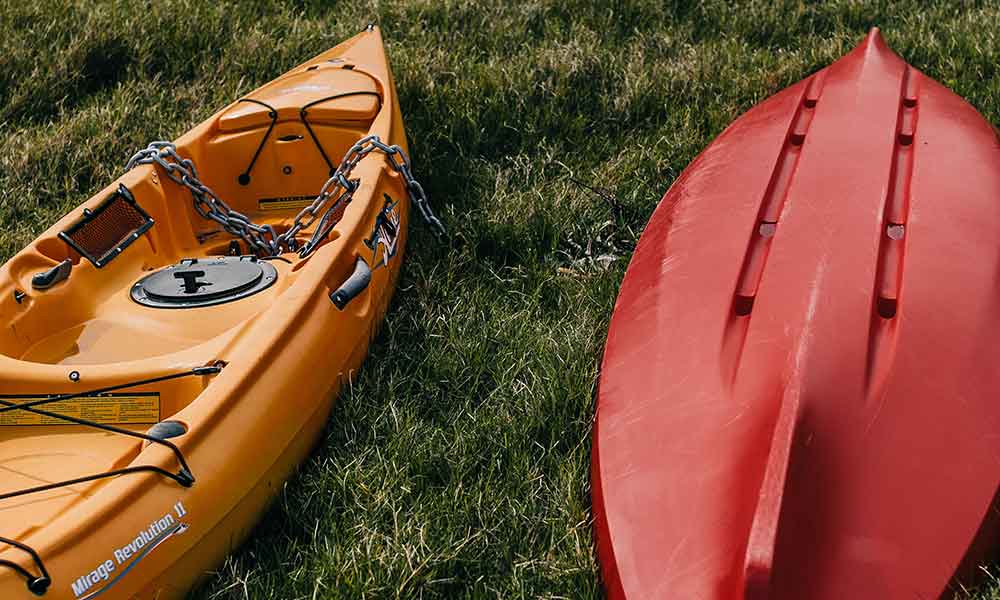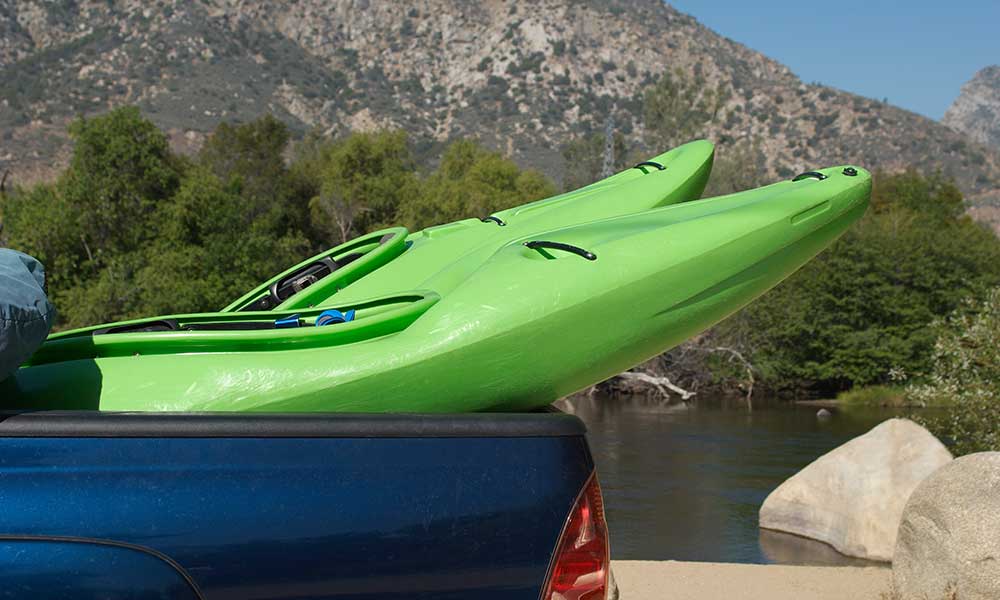Storing a kayak is an important aspect of kayak maintenance and care. The way you store your kayak is of particular importance if you will be storing it for the winter months and will not be using it for some time. We will show you the best ways and methods for storing your kayak and ensuring it will remain in good condition.
You can store your kayak either indoors or outdoors. A kayak should be stored off the ground and protected from the elements, damage, distortion, and theft. The kayak should not be stored flat for long periods and should be protected from temperature extremes. Clean the kayak before storing.
Modern kayaks are not cheap, and as such, you need to protect your kayak as much as possible when it is stored. The off-season where you do not use your kayak often is when the kayak will be stored for the longest duration and is most likely to suffer from poor storage. There is a wrong way and a right way to store your kayak, so read on to find the best ways to store your kayak safely.
What Is The Best Method For Kayak Storage?
A kayak is a fairly bulky item that takes up significant storage space. This poses a challenge for many people regarding the best location for storing their kayak.
Location is not the only consideration to consider when finding the ideal place to store and protect your kayak. Several factors should be considered in the kayak’s storage and include the following.
- Location. Indoors or outdoors
- Temperature. Kayaks can be damaged by temperature extremes.
- Prevention of moisture. Kayaks should not be kept in damp conditions.
- Protecting the structural integrity of the kayak. Kayak orientation in storage is important.
- Protection from animal damage. Store your kayak correctly to keep critters out.
We will discuss these key kayak storage considerations to ensure your kayak is protected and will be in good condition for the next kayaking season.
Storing Your Kayak Indoors
Storing your kayak indoors is the ideal storage location since this immediately offers the kayak protection from the elements and keeps it out of sight from would-be thieves.
Even though indoors is the ideal location to store your kayak, some aspects of indoor storage should be considered to maximize the kayak’s protection.
When figuring out where to store your kayak, look for any open space that can easily accommodate its size and allow you to access it easily. You also do not want it to be in the way of other items in the space or other activities the space is used for.
Ensure that no windows nearby could allow sunlight to fall on your kayak for long periods. Likewise, ensure that the temperature never gets too high or too low in the space you use to store your kayak.
Indoor kayak storage conditions can be anywhere from a mounting rack on your living room wall to make your kayak a functional piece of wall-art while it is being stored or your garage or a garden shed.
People who live in apartments may have storage space allocated to them in the building basement, which could also be a good place to store your kayak. Another indoor storage option for apartment dwellers is to rent storage to house the kayak and keep it safe and secure.
Any structure that provides shelter for your kayak is preferable to storing the kayak outdoors, so long as the conditions indoors do not compromise the other storage requirements for the kayak.
Storing Your Kayak Outdoors
Storing your kayak outdoors is not ideal, but it is sometimes unavoidable. Some people simply do not have the indoor space to accommodate the storage of a bulky kayak.
If you intend to store your kayak outdoors, consider finding protected areas such as under a deck or below the eaves or similar locations that offer maximum shelter from the elements and prying eyes.
If storing your kayak outdoors is your only option, you should take the following precautions for long-term outdoor kayak storage.
- Do not wrap the kayak in a tarp. Wrapping the kayak in a tarp can trap moisture, leading to mold growth in the kayak. The temperature under the tarp can also become too hot. Drape the tarp over the kayak rather than wrapping it in the tarp.
- Keep the kayak out of the sun. You may consider the winter sun to not have enough power to cause damage to the kayak, but this is not the case. The UV from the sun can still degrade the kayak’s material.
- Keep the kayak off the ground. Raise the kayak off the ground to prevent damp and provide better temperature control. The winter temperatures are colder at ground level.
- Always remove soft seats and materials from the kayak. This will prevent these items from being damaged during outdoor storage and help prevent mold.
- Close the kayak cockpit. Sit-in kayaks should have their cockpits closed with a breathable material. This prevents access to rodents and creepy crawlies and allows moisture to dissipate from inside the kayak.
The ideal way to store a kayak outdoors is on a kayak rack mounted to a wall of a structure, such as your house, garage, or shed. This keeps the kayak off the ground, protecting it from getting too hot or too cold, and prevents accidental damage from other activities in the garden.
Some kayak manufacturers produce kayak storage bags, which are breathable, but still offer protection to the kayak. Such a kayak storage bag is a good idea whether you store the kayak indoors or outdoors!
Protecting The Kayak From Temperature Extremes During Storage
Whether you store your kayak indoors or outdoors, the temperature in the storage location should be considered.
The construction material of the kayak, be it composite material or plastic, can be damaged by high temperatures or extremely cold temperatures. Kayaks should not be stored in temperatures below 32°F or 0°C or temperatures above 100°F or 37°C.
When storing kayaks indoors, ensure the kayak is not kept near a heat source, such as the boiler in the basement, against a wall that becomes hot from the sun, or a window that allows sunlight to fall directly on the kayak.
For outdoor storage, keep your kayak off the ground by using a rack or placing it on bricks or timbers to elevate it off the ground. A covering in the form of a tarp or similar material will help control temperatures and prevent the kayak from becoming too cold or too hot.
If you have extremely cold winters, renting indoor storage for your kayak to protect it from the extreme cold would be preferable. Many kayaking clubs offer storage space to rent for this purpose.
Don’t Store Your Kayak In Damp Conditions
Damp storage conditions are not suitable for your kayak, especially for long-term storage. The storage location for the kayak, whether indoors or outdoors.
Damp conditions promote mold growth inside the kayak, and the constantly moist conditions can degrade the kayak’s construction material, especially in wood and composite kayaks.
Mold growth in the kayak can be a health hazard, and the high humidity can cause the inside of the kayak to become smelly and unpleasant.
Before you store your kayak, always ensure it is completely dry, and there is no residual water in the kayak’s cockpit or any storage compartments.
For indoor storage, do not store the kayak in areas where the kayak will be exposed to steam or other high humidity areas.
For outdoor storage, do not store the kayak directly on the ground or where the kayak may get wet from precipitation.
How To Protect The Kayak Structure In Storage
Kayak materials are generally able to flex, which is often a feature built into the design of the kayak structure.
Due to the flex of the material, it is not recommended to store a kayak flat, either upside down on the deck or right side up on the hull, for long periods. Storing the kayak in this way places stress on the hull or deck and can create micro-fractures in the material, which will compromise the structure of the kayak in the long term.
The best orientation to store a kayak to protect its structural integrity is to store the kayak with its weight resting on the edge of the kayak. This is the strongest structure of the kayak and the area that has the least flex.
The best storage mechanism is in a rack that supports an even distribution of the kayak’s weight and allows the kayak to be stored on its side. It is a fairly simple project to build a custom kayak rack using PVC pipes, or you can buy commercially manufactured kayak racks.
Given this ideal storage orientation, it is best to store the kayak in this way, whether you are storing it outdoors or indoors.
It is also unsuitable to store a kayak slung in straps suspended from the roof. The straps around the hull or the deck will create stress in the flexible materials in these areas and damage the kayak.
Never hang your kayak from any of the handles or securing points on the kayak. They are not intended to hold the kayak’s weight continuously for extended periods.
Can You Store Your Kayak Vertically?
Some people stand their kayak vertically to use unused space on a wall or in a corner. Is this a suitable storage method for your kayak?
A kayak can be stored in this orientation since the kayak’s stern is usually a rigid, strong structure on the kayak. It is best to stand the kayak on the stern rather than the bow since the bow-end is usually narrower than the stern.
Stand the kayak vertically with it standing on its stern. The part of the stern resting on the floor can be raised slightly with supports and protected with padding to elevate the kayak from the floor.
The kayak’s body can then be tied to a structure on the wall using a strap that is not cinched down too tight or even a simple bungee cord. This will prevent the kayak from falling over.
The straps or bungee cord can be secured to studs that you install in the wall, to a framework that you manufacture and fix to the wall. You can also secure the kayak to exposed pipes on the wall, as long as they are not heated pipes.
Although the vertical orientation is an acceptable way to store your kayak, it must be noted that this manner of storage should only be a short-term option. Over-wintering in this way is fine, but storing a kayak for extended periods such as a year or two can damage the kayak.
This is due to the kayak’s weight over time, placing excess pressure on the structure of the kayak’s stern. This can eventually distort the stern where the kayak’s weight is supported.
Protect Your Kayak From Animal Damage In Storage
Long-term storage of a kayak can pose some risks of animal damage if it is not sufficiently protected.
Rodents are a particular problem with sit-in kayaks since they view the kayak’s interior as a safe, dry place where they can make a home and raise a family!
The urine and feces of these animals are not only a health hazard to the kayaker, but these waste products can produce an acidic environment that can damage the kayak.
Rodents will also chew the kayak and components inside the kayak, which will cause unnecessary damage.
The best way to prevent pests and other animals from gaining access to your kayak is to make sure all compartments are closed, including the cockpit of sit-in kayaks, and storing the kayaks off the ground.
Storing the kayak raised off the ground also prevents pets from accidentally damaging your kayak by jumping on it or knocking it over.
Clean Your Kayak Before Storing It
Part of storing a kayak correctly is preparing it for a long period when it will not receive any attention. This includes cleaning the kayak thoroughly before storing it.
Soft seats and any components made from foam should be removed from the kayak’s interior before washing or storage. These items absorb moisture during storage and can be a starting point for mold to grow and thrive inside the kayak.
Seats and other soft materials can be washed and stored separately from the kayak, such as in a storage box in a closet or in your garage.
To wash the kayak, spray the entire kayak down with clean water. Use a sponge and a little dishwashing liquid in a bucket of warm water to wash down the kayak, both inside and out.
Once you have washed the kayak thoroughly, rinse it down again with clean water to remove any soap residue. Dry the outside of the kayak thoroughly with a soft, absorbent cloth.
Be sure to open any drainage plugs and allow the water to drain completely from the inside of the kayak. It is a good idea to give the kayak some time to air-dry in a cool shady location before storage. This will allow any damp areas of the kayak to dry out properly before the kayak is stored.
Conclusion
In many regions, kayaking is a seasonal sport, implying the kayak will be stored during the off-season. Many people are unsure about the correct storage of their kayak, which results in problems and potential damage to the craft.
Clean your kayak before storage and ensure that it is well protected in a dry, temperature-controlled location and where the elements and animals cannot damage it. Support the kayak properly to prevent structural damage during long storage periods, and your kayak will be in good condition when kayaking season comes around again!







